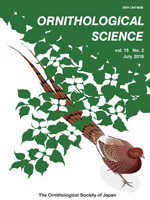Although the relative importance of land use and climate to large-scale bird distributions has received great attention, it is difficult to separate the effects of land use and climate, and there are few studies on bird abundance distributions on a large scale. Here, we examined the effects of land use and climate on the abundance of the nocturnal Jungle Nightjar Caprimulgus indicus in Hokkaido, northern Japan. We chose 125 sampling sites with low correlations (|r|<0.58) between land use and climate, and combined a playback method with a hierarchical model (N-mixture model). We thereby accounted for the possibility that we could not detect all individuals during the field survey. Results show that Jungle Nightjar abundance was greater at sites within a 4—km radius of moderate forest cover (∼75%) and with high average temperatures during the breeding season. Moreover, the effects of land-use were greater than those of climate. Mapping predictions of Jungle Nightjar abundance indicated that suitable areas are distributed in southern and central Hokkaido and around the margins of montane zones. Factoring in the covariation of land use and climate, land use may be the most important driver of the distribution of the Jungle Nightjar in Hokkaido.
BioOne.org will be down briefly for maintenance on 17 December 2024 between 18:00-22:00 Pacific Time US. We apologize for any inconvenience.
How to translate text using browser tools
1 July 2016
Effects of Land Use and Climate on the Distribution of the Jungle Nightjar Caprimulgus indicus in Hokkaido, Northern Japan
Kazuhiro Kawamura,
Yuichi Yamaura,
Masayuki Senzaki,
Yuki Yabuhara,
Takumi Akasaka,
Futoshi Nakamura
ACCESS THE FULL ARTICLE

Ornithological Science
Vol. 15 • No. 2
July 2016
Vol. 15 • No. 2
July 2016
abundance
forest cover
N-mixture models
playback
topography




